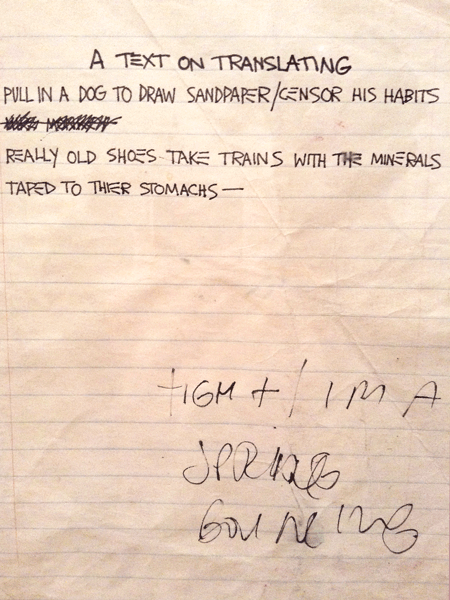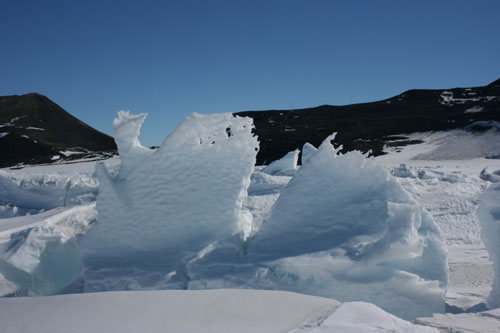Bright arrogance, gallery B
Transduction, transposition, translation

It is a truism for the experimental translator that as Google Translate gets better, it actually gets worse. Witness the demise of the ability to "Turn Your Google Translate Into a Beatbox." If you follow the instructions now, you only get a perfunctory recitation of consonants, alas. Yet, at one point you were able generate drum-machine phonemes by translating certain consonant clusters from German INTO German (an operation itself which is now impossible to perform), and then activating text-to-speech:
zk = suspended cymbal
bschk = snare
pv = brush
bk = bass
tk = flam1
vk = roll tap
kt = flam2
kttp = flam tap
krp = hi hat tap
pv = short roll
th = better hi hat
thp, ds = instant rimshot.
The temporary nature of this conjunction, however, between beat box and translator, may be crucial to thinking the relation of translation to the phenomena of technological "transduction," as an evanscent rather than fixed potentiality of any technological assemblage.
Were we to create a full overview of how transduction and media transposition have impacted cultural, translational processes, our task would be an impossible one. But let's at least start with an instance that could serve as a metaphor for the rest. A simple technological example of transduction is what happens when, for example, a sound wave is encoded into positive and negative electical charges (via a microphone) and then reconstituted as sound again at the end of a communicative chain (via speakers or headphones). But transduction as artistic transformation may, for example, not concern itself with an ultimate resolution and reconstitution at the end of such a chain, but rather, dwell in the strange outputs that emerge when one transposes a signal (rather than a "message") from one medium to another, morphing through different registers of meaning, encountering new connections and carried along by new vectors. See, for example, "celebrated nightclub organist and inventor" Quintron's recent experiments synthesizing weather patterns. From mechanical translation generating Khlebnikovian zaum music to earthquake data turned into music for scientific purposes, there are infinite territories that these types of transmedia transpositions encompass, both positivistic and 'pataphysical.
Andrea Polli's work centers around various forms of transcoding and sonification of data, and like many in her field, her work seems to explore a positivistic, utilitarian translation of imperceptible signals, quantities and effects into something more sensible. It's the art world extrapolation of such thought experiments as "if you laid x dollar bills end on end, it would circle the earth ten times/ go to the moon and back/ make an elegant settee." But if we consider the applicability of Gilbert Simondon's definition of transduction, as described by Adrian Mackenzie, these types of media translations take place in orders both larger and smaller than the original; transduction is both more and less than a translation, and marks the horizon of insufficiency for translational identity with the original. While projects like Quintron's live weather feed may not have the same policy implications as those of Polli—who has created installations and sound art pieces that body forth the weather, stock market data, and air quality—there always is a sort of excess (or productive deficiency), an artistic element that cannot be captured by a strict translation into rational ends.

Click image for Polli's Sonic Antarctica.
There's a point, as in the work of Carrie Bodle, when we wonder if the original matters any more; are the pure abstractions of data embodiment meant to draw visitors back to some apperception of the source, or engage them in new combinations of sound and light only possible through the indeterminate interplay of artistic practice, technology, and the natural world?
This type of translation need not be pure conceptual abstraction (if "pure conceptual abstraction" exists as such). In Steve Elkins' remarkable documentary about sound artists who do politically-engaged sonification work, we can see how art based on transductive practices can engage political realities in ways that neither try to capture nor exploit the social origins of the work, nor force a clear "message," but rather reveal something about the fabric of collective that might otherwise be lost with a purely humanistic approach.
Why might these forms of media translation be important for literature? Precisely because they announce that the poet is always becoming something else as s/he encounters these transductive assemblages. . . . that the poet must translate poetry out of itself. Even removing "translation" from the equation is necessary; "transduction" and "transposition" are not synonymous with "translation," but rather herald a different quality of connectivity—something that media artists have had no problems with, but poets, in their tortured acrobatics meant to conserve translation, still cannot quite grasp.
For Friedrich Kittler, "the untranslatability of media is essential to the possibility of their coupling and transposition," and, for him, it was only poets who were astounded by this development. One of the profound implications of the shift from what he calls discourse network 1800 to discourse network 1900 is the decline of the transmissional hegemony of poets, and the rise of signifying machines that would record, archive, and transmit in ways that did not make any detours through the word and the word's animating counterpart in human consciousness.[1]
Traditional translation, then, according to Kittler, is a type of analogue process, which "excludes all particularities in favor of a general equivalent." For example, while something like Sophia La Fraga's translations of Waiting for Godot and The Bald Soprano into IM conversations are transpositions that engage with the performative potential of online, digital communications, they are still conceptually analogue.[2]
Whereas media transposition is accomplished discretely, either at random, indeterminate points (this would be the artistic mode) or mathematically (the systemized transposition of 44,100 samples per second, the resolution of 72 pixels per inch, etc.) Because human consciousness is not involved (and of course, this is the machine's advantage and cunning, but also its terror), a message could be subsumed by non-individuated orders of transposition (that is, orders that may not replicate the general sense of the original, but which may either under- or overcode it).
The non-individuated aspects of transductive-translations, then, imply both the disruption of the individual unitary text as well as the individual author. For example, when Angela Genusa translates Gertrude Stein's Tender Buttons into mojibake (a paradoxical translation into a kind of computer noise that appears when computer translation breaks down), she perhaps admits that the translation has nothing to do either with Stein—even though the translation of an already indeterminate modernist text into computer noise is conceptually apropos—or herself. Rather, it articulates something about the condition of the literary work in general, just as Stein might have aptly articulated the ways in which the seeming domesticity of "objects," "food," and "rooms," was glitched out by transatlantic travel, mechanized war, and the modern city. And in the process, there is an unexpected beauty discovered, and the potential for the emergence of a new ideolect. Dare we translate this posthuman portmanteau back into the sense of a lake—an n-dimensional lake of the late on the edge of the vast quiet of a double infinity?

While this form of transmission may be consummately scientific and regularized, it can potentially produce literary grey goo. But, in many cases, for those who are open to their own translation, it can be a (dys)synaesthetic revelation. For instance, what if we transcoded emoji into something that might very well capture an affect for which there is as of yet no sign?
Tomorrow, Saturday May 9, Wave Farm's WGXC will feature sound works related to transduction. At 11 AM EST, Quintron's Weather for the Blind will be featured as part of "Curated by Wave Farm: Climactic Climate", a series commissioned by Kunstradio, Vienna. At 8 PM, performances from Columbia University School of the Arts Sound Arts MFA program will be broadcast, in conjunction with the exhibition Amplitude, which was curated by Wave Farm and took place at Pioneer Works in Brooklyn April 2015. The broadcast features, among other works, the transductive assemblages of Nolan Lem. Visit https://wavefarm.org to listen.
1. For Kittler, what is at stake in this historical transformation is also the future of psychoanalysis, given that Freud recognized the necessity of transposition (from unconscious to conscious, from surreal rebus to talking cure to scientific discourse), yet insisted on the primacy of the verbal. Lacan would radicalize this stance by asserting that it was language all the way down, rather than admit extra-linguistic phenomena into psychoanalytic concerns (this stance would be dismantled by the more machinic, transduction-friendly ontologies of Deleuze and Guattari). This notion that the proper domain of psychoanalysis is the symbolic is literalized by Simon and Christine Morris's "translation" of Freud's Interpretation of Dreams via the Lingo Algorithm (which operates by way of the suggestively named "Latent Semantic Indexing Technique"). In their book Re-Writing Freud (one potential instantiation of this translational process, although there is an app that will generate others), the shape and content of the original is uncannily maintained, but the words have all been jumbled. Just as Lecercle posits homophony as deformational procedure that can undermine the symbolic from within the symbolic, granting us a sense of the Real, Craig Dworkin in his introduction to Re-Writing Freud suggests that Morris similarly uses the symbolic to access what is normally barred from it:
Without the filter of human psychology to make such associations meaningful, Re-Writing Freud tries to place its language beyond analysis, not only in the grammatical sense but in the psychoanalytic sense as well. Indeed, Morris' work would seem to be an attempt to thwart the symbolic itself, and to momentarily snare some fragment of the real. Through the ruse of chance, his stratagem of stepping back and leaving the writing to the computer, Morris presents a glimpse of how language—the symbolic system underwriting the symbolic dream-work that articulates our psychological symbolic order—might appear in the guise of the real: a sheer inexpressive materiality composed of language, but no longer functioning as language.
2. I would not want to discount the analogue, and by association analogical, processes, however. As Douglas Hofstadter and Emmanuel Sander note in their book on analogy, good translation is inseparable from a highly developed sense of analogical aptness. They use this argument to defend "good" human translation from the incursions of the machine, which in some ways would be antithetical to the arguments I am setting out here. Yet, the dismantling of analogical thinking (as analyzed by writers as diverse as Edgar Allan Poe, Michel Foucault, Antonin Artaud and Barbara Maria Stafford), while part of the larger project Enlightenment rationality and scientific progress (given its close affiliation with alchemical cosmology), threatens to rationalize all human discourse into questions of number, and all statements into mere announcements of power.
- 'pataphysics
- Adrian Mackenzie
- Andrea Polli
- Angela Genusa
- Carrie Bodle
- Christine Morris
- Craig Dworkin
- experimental translation
- Friedrich Kittler
- Gauss PDF
- Gertrude Stein
- Gilbert Simondon
- Jean-Michel Basquiat
- new media
- psychoanalysis
- Quintron
- Scott Gelber
- Simon Morris
- sonification
- Sophia Le Fraga
- sound art
- Steve Elkins
- transduction
- translation
- transposition
Bright arrogance